

Parameter: Reservoir-Rock(cont.)
One of the biggest lies of geoscientists, and in particular of petroleum geologists, is to think that from the study of electrical logs (SP, Gamma Ray, etc.,) they are able to understand turbidite deposit systems and make predictions about the most likely location of potential reservoirs. The understanding and, especially, the lithological predictions in turbidite systems, as in any dissipative system, can just be approached by global studies, i,e, the only ones which make possible to understand part of the mechanism deposit. However, as our decision-makers, to whom we advise to read "The end of certainty, Time, Chaos, and the New Laws of Nature" (I. Prigogine, The Free Press, New York 1997), do not like uncertainty, most geologists are obliged to propose geological models, which in reality are only ad hoc hypotheses.
Below, we will illustrate some examples we believe are more than sufficient to show the mistakes that can be made when geoscientists working in oil companies are forced, by management personnel, to make predictions in basins that are not appropriated or with poor seismic data inappropriate for an accurate high hierarchical sequential interpretation (after next autotrace), particularly, when they are quantified in terms of probabilities.
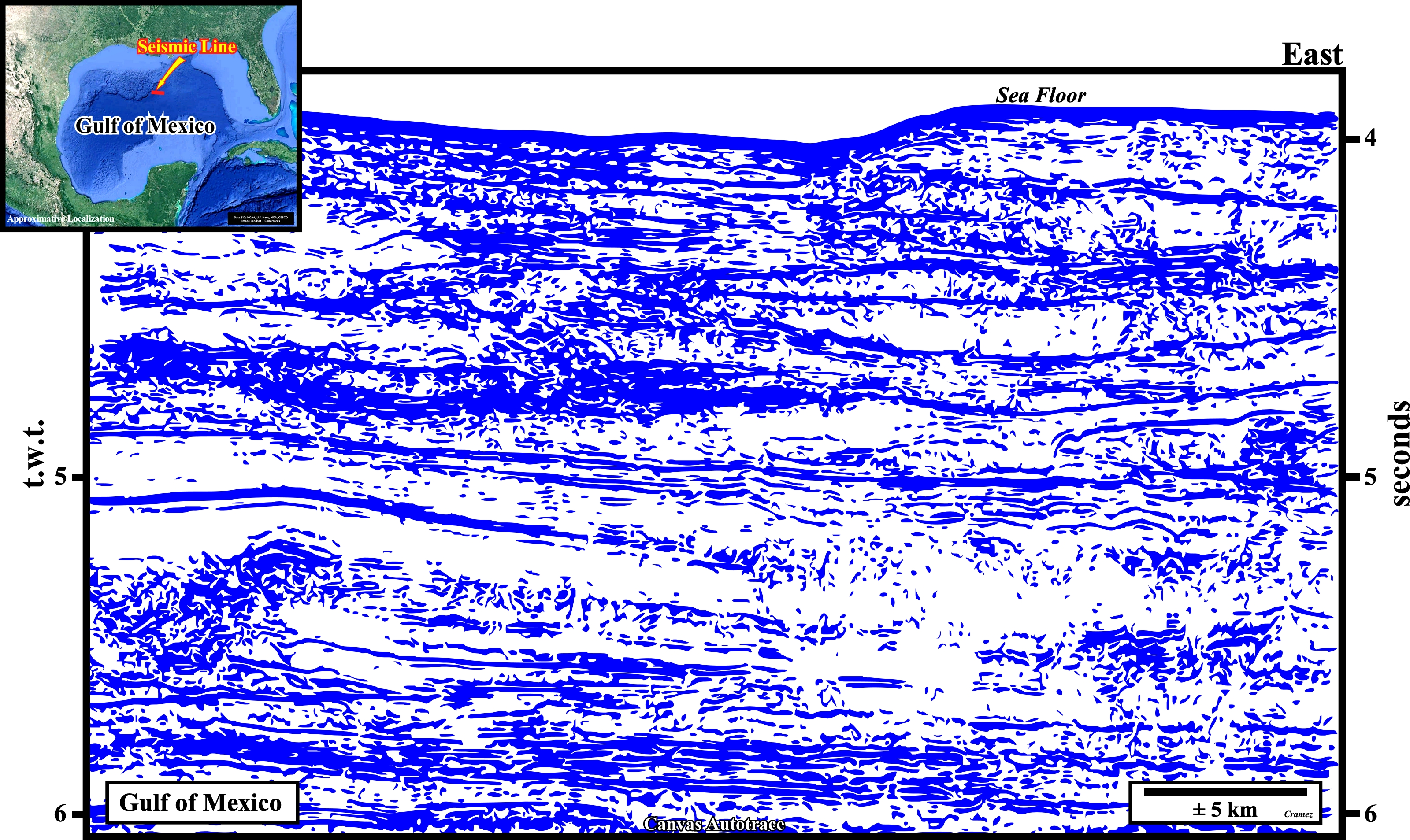
This Canvas autotrace of a seismic line of the Gulf of Mexico, which location is, almost entirely, beyond the Sigsbee escarpment, i.e., in an area where salt tectonics, during the Cenozoic, is, practically, non-existent , suggests in this area, the turbidite systems are organized, roughly, following the model proposed by Peter Vail (1977). In fact, the turbidite currents having a great degree of freedom were able to organize themselves according to the laws of nature. However, as you recognize, easily, on this autotrace the sequence boundaries, i.e., the unconformities or the correlative deep-water para-conformities bounding the sequence-cycles, are impossible to highlight, which prevents the individualization of the sequence-cycles. In other words, the lithological prediction of the depositional systems tracts composing them are impossible. On this kind of seismic data, a geoscientist can just say the sequence-cycles are incomplete, composed, probably, by lowstand systems tracts groups, i.e., by basins floor fans, slope fans and lowstand prograding wedges, very difficult to individualize. Lithological predictions, using a scientific approach, which requires an interpretation at para-cycle sequence hierarchical level, are impossible. Only guesses can be advanced.
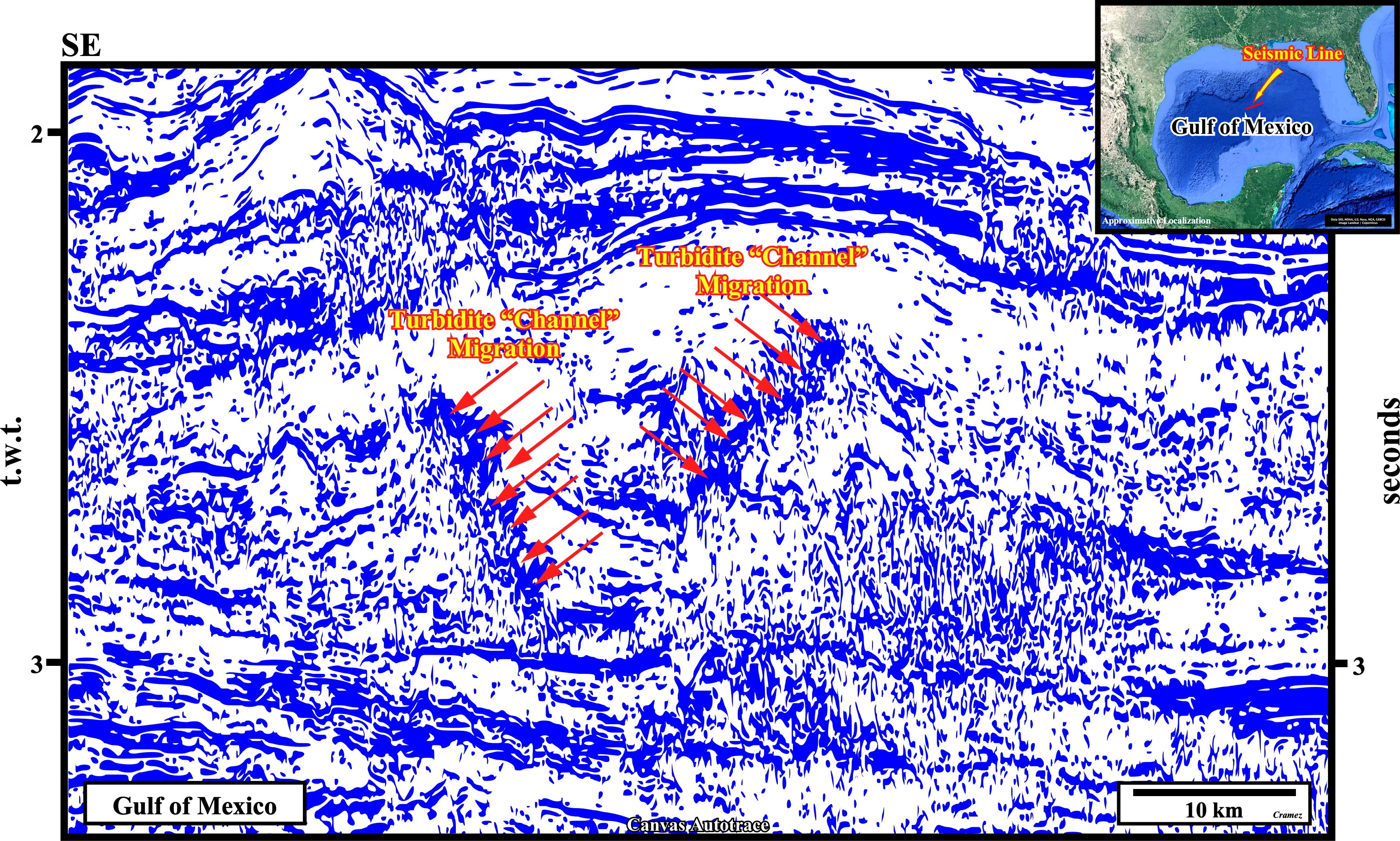
On this Canvas autotrace of a GOM seismic line, roughly, not far from the previous one, a vertical and lateral repetition of the same depositional systems, which correspond to the lowstand deposits of P. Vail., is, quite, evident. The slope fans seem to overlap each other with a very pronounced pendulum effect. Overflow deposits and turbidite "channel" fill deposits, which are, easily, recognized, appear to be repetitive and auto-similar (they appear to have a fractal morphology). The complexity of the turbidite "channel"-levee deposits is, here, characterized by the migration of the turbidite "channel", which, often, corresponds just to the depression along which the turbidite currents flow without significant erosion. If that's true, it means the deposition of the over-bank deposits (turbidite levees) predates the filling of the central depression (turbidite channel in case of erosion).
The shift to probabilities, i.e., the probability of an hydrocarbon discovery (P) defined as the probabilities of presence of trap, source-rock, reservoir rock, migration and retention: Pdiscovery = Ptrap x Psource-rock x Preservoir-rock x Pmigration x Pretention is also one of the great misapprehension in oil exploration. In this regard and without going into the detail, I remind the probabilities are not falsifiable (refutable). They are not verifiable and this for the same reasons as those which play for other scientific hypotheses, experimental results, as numerous and favorable they are, will never be able to establish, definitively, that the relative frequency of the faces in the launches of a coin is 1/2 and will always be 1/2. Statements of probability and basic statements can therefore neither contradict or mutually implicate (K. Popper, 1934- The Logic of Scientific Discovery).

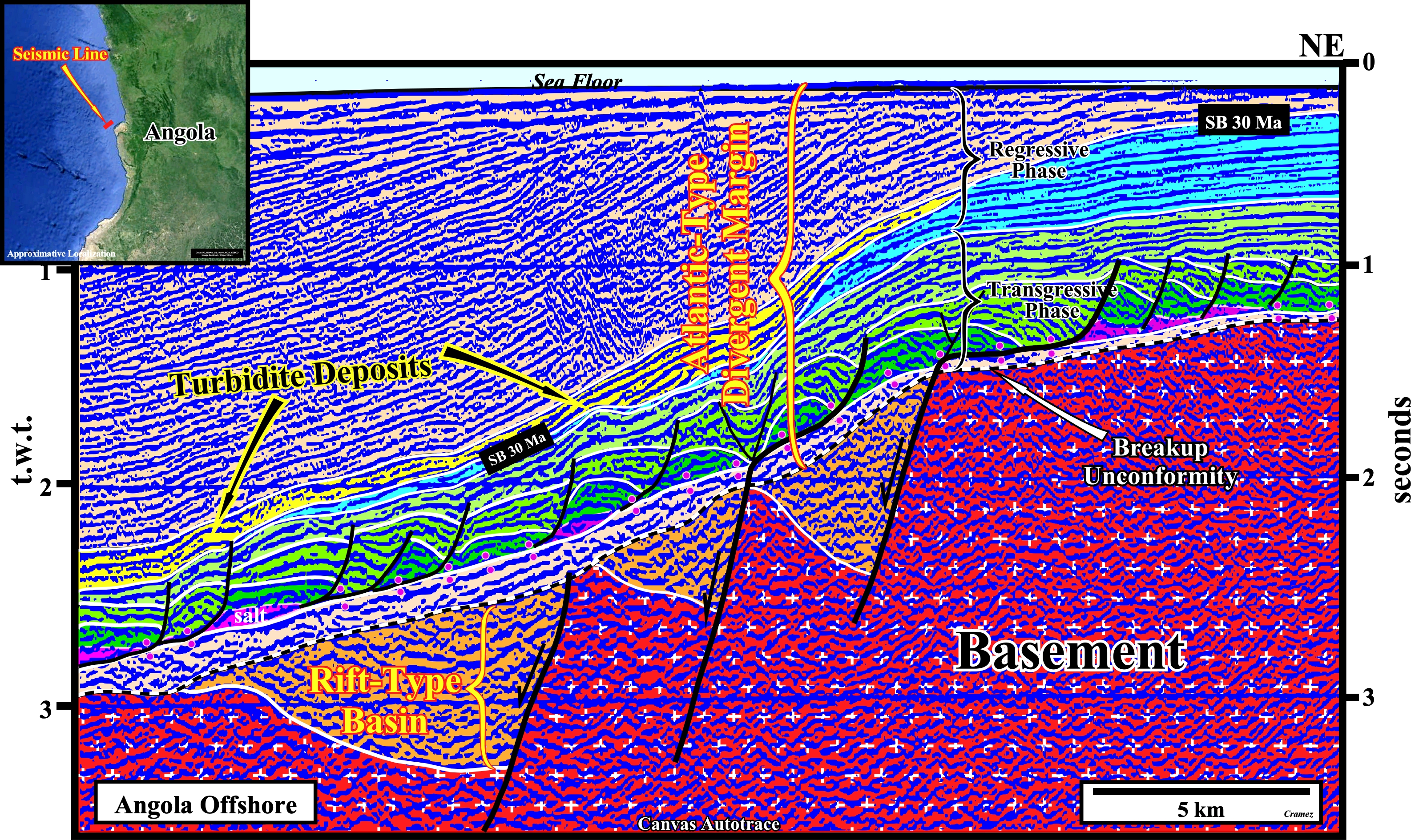
On this tentative geological interpretation of a Canvas autotrace of a seismic line of Angola offshore (near Luanda offshore), it is easy to see the salt tectonics, in this area, stopped at the beginning of Upper Cretaceous. No salt raft or abnormal depocenter is visible above the major downlap surface of the post Pangea continental encroachment stratigraphic cycle, i.e, above the Middle Turonian. As at the beginning of the Cenozoic (bottom of the blue interval), the continental slope does not present significant bathymetric anomalies, gravity currents and turbidite deposits could organize themselves. As soon as the currents reached the lower continental slope break, they decelerate and start to set down their terrigeneous supply under the form of sediments (matter that has been deposited by some natural process), like any SOC system, that is to say, more or less, according to the P. Bak's sandpile model. It is therefore possible that at this location one can find a staking of depositional systems similar to those proposed by P. Vail.
When a geoscientist says in a certain basin and at a certain location there are a 20 % probability of making an hydrocarbon discovery (P discovery = 20), that means if 100 exploration wells will be drilled, 20 discoveries will be made. However, this deterministic thinking has no sense. If the 1st exploration well is negative, generally, the management personnel of the majority of oil companies refuses a second or third well. On the other hand, as in quantum physics, we must challenge the accuracy of all the components of the Creed of modern science. The current world, dominated by uncertainty, incompleteness and unpredictability, is radically different from yesterday world (Laplace's determinism). The principles of chaos, theory of quantum physics and other strange things as the Gödel's theorem (all the logical system based on mathematics, i.e., formalized in a rigorous way, is either complete or coherent, but not both at the same time, i.e., whole logical system consistent is incomplete), must be integrated in petroleum exploration evaluation. All you known, we will never be able to know (i) the position and the speed of a particle at the same time, (ii) to have a system of axioms both complete and coherent, (iii) to predict with accuracy the weather and (iv) to predict in quantifying the probabilities of a hydrocarbon discovery, using seismic data, is unintelligent.
As turbidite depositional systems are (submarine basins floor fans and submarine slope fans) contain the most likely potential reservoir-rocks in deep water offshores, it is interesting to show the most proposed models for slope and basin depositional systems.
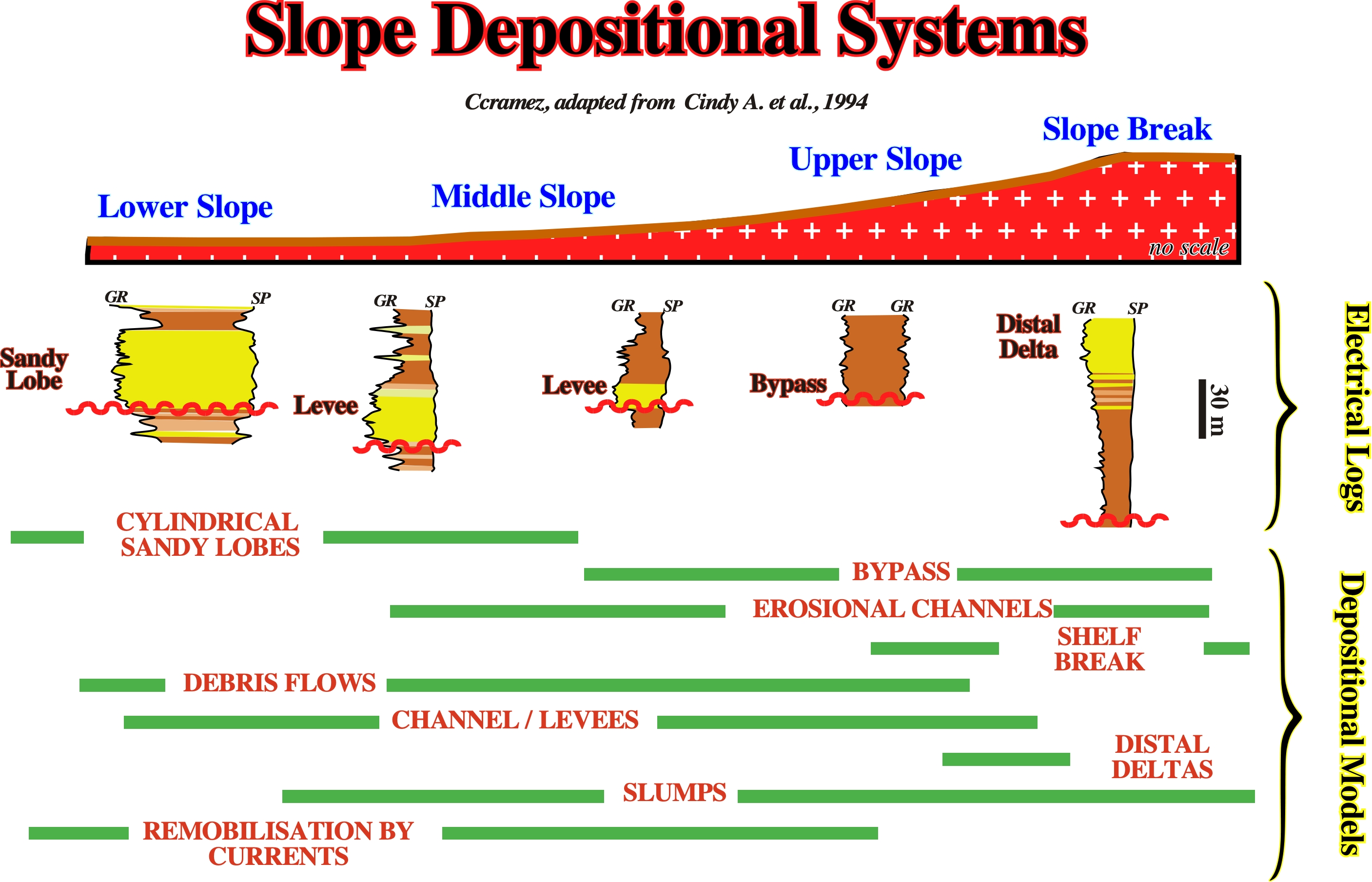
¨This diagram illustrates the most probable sequence of turbidite reservoir-rocks encountered in a continental slope when the gravity currents have a fairly high degree of freedom. Roughly, this model corresponds to the proposed by P. Vail proposed for a geological context of platform / shelf break / slope. Note, however, the absence of channel fillings. This succession of turbidite bodies is, often, found in the distal parts of the Gulf of Mexico where the seabed is hardly affected by salt tectonics.
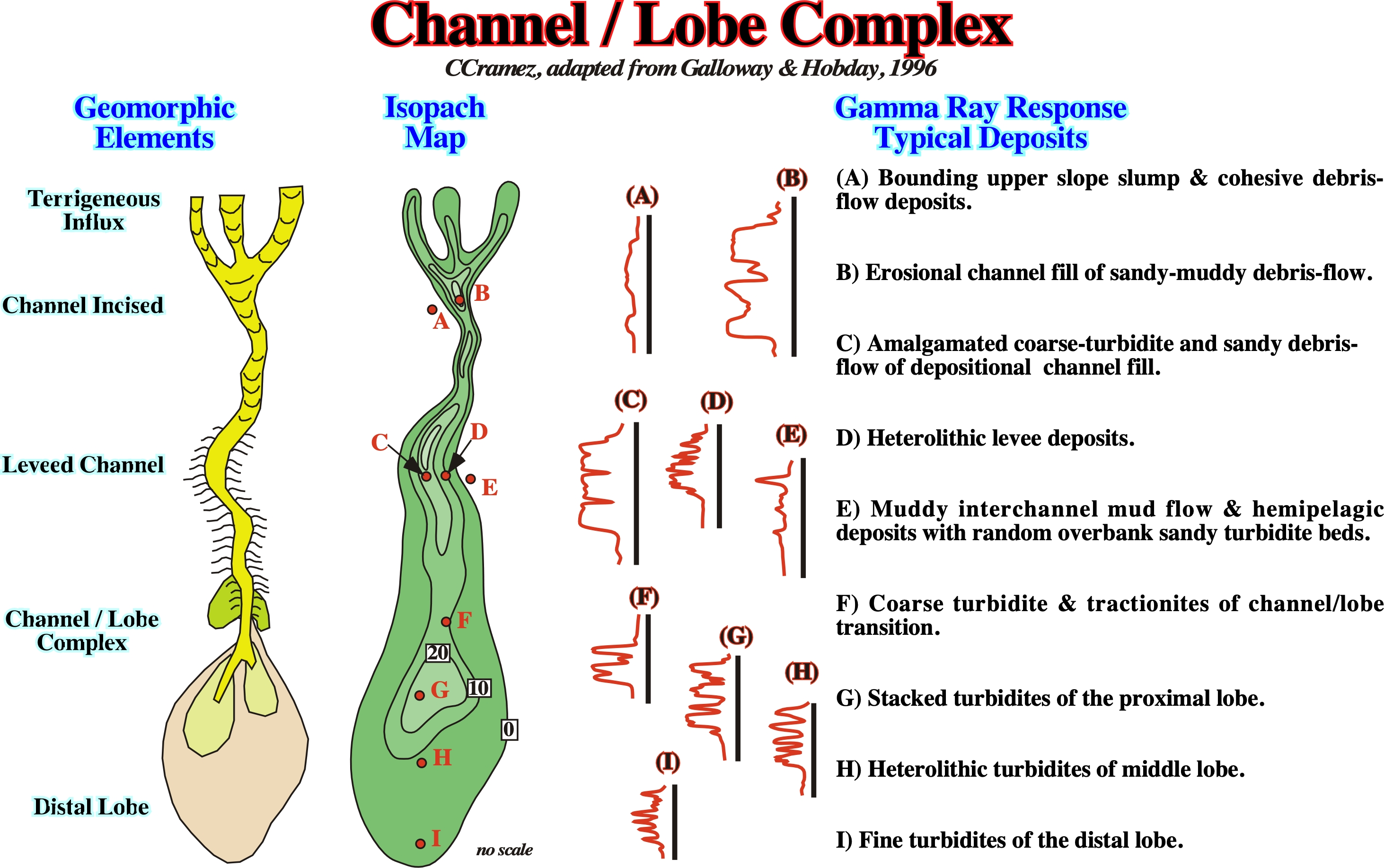
An ad hoc turbidite deposit model was proposed by Galloway for turbidite deposited in, more or less, straight paths between two rising salt masses. This model, which seems to be build-up on seismic data, electrical logs and cores taken in exploration wells located at the entrance of a salt expulsion basin ("mini basin "from American authors, it is especially necessary to underline the succession, downstream : (i) Infill of incised channels ; (ii) Channel-levee complexes ; (iii) Channel / lobe complexes and (iv) Fine and thin turbidite deposited in the distal part of the lobe. In such a geological context, the trajectory and the speed (competence) of the gravity currents are very dependent on the saliferous movements. Turbidite systems being far from the point of equilibrium, local changes in initial conditions produce the emergence of new structures and forms. Some geologists, as Montgomery, S. C. (1997), observed the formation of channel-levee complexes and channel infills without levees, or overflow deposits inside clay infills. The deposit of amalgamated sandy lobes is observed in places where the distance between the salt walls is the narrowest.
An classification of the turbidite reservoirrocks of the Gulf of Mexico in (i) Levees , (ii) Channel Complexes and (iii) Sand Lobes was proposed by Mahaffie (1994).

Following the exploration wells made in the central part of the Gulf of Mexico, where the morphology of the sea floor is affected by the salt tectonics and where the formation of sedimentary mini-basins (salt expulsion basins) is very frequent, the trajectory and the speed of the currents of gravity are very disturbed, which gives rise to very varied and particular turbidite deposits. The morphology and geometry of these reservoir-rocks, whose petrophysical characteristics are, often, excellent, have nothing to do with the conventional model proposed by P. Vail's model (there are sliding deposits and debris flows induced by diapir uplift of salt walls). In these ad hoc depositional models are recognized, often, turbidite levees with its typical morphology in the form of gulls' wings, more or less, discontinuous or shingled channel infills and very continuous lobes, either amalgamated or inter-bedded. The morphology of the electrical logs associated with these turbidite bodies is very similar to that illustrated in this figure.
Send E-mails to carlos.cramez@bluewin.ch with comments and suggestions to improve this atlas.
Copyright © 2001 CCramez
Last update:
2022